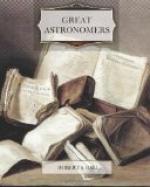worthy of their speculative grandeur. The stars
are the landmarks of the universe; and, amidst the
endless and complicated fluctuations of our system,
seem placed by its Creator as guides and records, not
merely to elevate our minds by the contemplation of
what is vast, but to teach us to direct our actions
by reference to what is immutable in His works.
It is, indeed, hardly possible to over-appreciate
their value in this point of view. Every well-determined
star, from the moment its place is registered, becomes
to the astronomer, the geographer, the navigator,
the surveyor, a point of departure which can never
deceive or fail him, the same for ever and in all places,
of a delicacy so extreme as to be a test for every
instrument yet invented by man, yet equally adapted
for the most ordinary purposes; as available for regulating
a town clock as for conducting a navy to the Indies;
as effective for mapping down the intricacies of a
petty barony as for adjusting the boundaries of Transatlantic
empires. When once its place has been thoroughly
ascertained and carefully recorded, the brazen circle
with which that useful work was done may moulder,
the marble pillar may totter on its base, and the astronomer
himself survive only in the gratitude of posterity;
but the record remains, and transfuses all its own
exactness into every determination which takes it
for a groundwork, giving to inferior instruments—nay,
even to temporary contrivances, and to the observations
of a few weeks or days—all the precision
attained originally at the cost of so much time, labour,
and expense.”
Sir John Herschel wrote many other works besides those
we have mentioned. His “Treatise on Meteorology”
is, indeed, a standard work on this subject, and numerous
articles from the same pen on miscellaneous subjects,
which have been collected and reprinted, seemed as
a relaxation from his severe scientific studies.
Like certain other great mathematicians Herschel
was also a poet, and he published a translation of
the Iliad into blank verse.
In his later years Sir John Herschel lived a retired
life. For a brief period he had, indeed, been
induced to accept the office of Master of the Mint.
It was, however, evident that the routine of such
an occupation was not in accordance with his tastes,
and he gladly resigned it, to return to the seclusion
of his study in his beautiful home at Collingwood,
in Kent.
His health having gradually failed, he died on the
11th May, 1871, in the seventy-ninth year of his age.
THE EARL OF ROSSE.
The subject of our present sketch occupies quite a
distinct position in scientific history. Unlike
many others who have risen by their scientific discoveries
from obscurity to fame, the great Earl of Rosse was
himself born in the purple. His father, who,
under the title of Sir Lawrence Parsons, had occupied
a distinguished position in the Irish Parliament,
succeeded on the death of his father to the Earldom
which had been recently created. The subject
of our present memoir was, therefore, the third of
the Earls of Rosse, and he was born in York on June
17, 1800. Prior to his father’s death in
1841, he was known as Lord Oxmantown.




